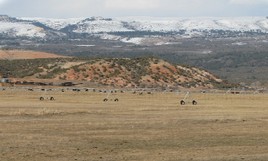Wyoming State Water Plan
Wyoming State Water Plan
Wyoming Water Development Office
6920 Yellowtail Rd
Cheyenne, WY 82002
Phone: 307-777-7626

Wyoming Water Development Office
6920 Yellowtail Rd
Cheyenne, WY 82002
Phone: 307-777-7626




PDF (113.3mb) Access the 2010 Wind/Bighorn River Basin Update Final Report here
PDF (674kb) Table of Contents for the 2010 Wind/Bighorn Basin Plan Update
PDF (136kb) The Wind-Bighorn Basin Plan Update (Basin Plan Update) provides an update to the previous 2003 Wind-Bighorn Basin Plan (previous Basin Plan).
PDF (383kb) Description of an Interactive Presentation Tool developed for the 2010 Wind/Bighorn basn plan update
PDF (2,062kb) This chapter describes the general physical, socioeconomic, legal and institutional setting for the Wind-Bighorn Basin.
PDF (1,756kb) This chapter presents the physical characteristics (quantity and quality) of surface water in the Wind-Bighorn Basin.
PDF (5,225kb) This chapter describes current water uses in the Basin. Water use includes both consumptive and non-consumptive uses. Consumptive uses are generally agricultural, stock water, municipal/domestic, industrial/mining water, and reservoir evaporation, while recreational and environmental uses are generally considered non-consumptive uses.
PDF (290kb) This report updates the original Wind-Bighorn River Water Basin Plan water demand projections. The water use projections were developed for agricultural, industrial, municipal, recreational and environmental water use in the Basin. Projections for years 2020, 2040 and 2060 are provided.
PDF (2,178kb) Water availability is the amount of water that is physically and legally available for new water uses in the Basin. Water availability was determined for surface water uses using a spreadsheet model.
PDF (219kb) Project opportunities and program strategies have been developed as part of the Basin Plan Update in an attempt to address existing and future water use issues in the Wind-Bighorn Basin (Basin) as developed by the Basin Advisory Group (BAG) and the basin planning team.
PDF (113kb) This chapter describes the process for developing strategies and the final list of opportunities. More information on program strategies is contained in Technical Memorandum 6.
PDF (126kb) The scope of the Wind-Bighorn Basin Plan update is to document current and future water uses within the Basin, adjust estimates of water availability based on recent hydrologic information, including the 2000.s drought conditions within the basin.
PDF (136kb) Wind/Bighorn 2010 Update Framework tables
PDF (4,987kb) Access the 2010 Wind/Bighorn River Basin Update Executive Summary here
The spreadsheet models developed for the previous Wind-Bighorn Basin Plan were used for the Basin Plan Update. These spreadsheet models were documented in Technical Memorandum 3B/3C Spreadsheet Model Development and Calibration (MWH 2003) of the previous Basin Plan. Except for updates to input data sets (documented in other technical memoranda as part of the Basin Plan Update) and the changes documented within the text of this memorandum, the spreadsheet models remain mostly unchanged from the previous Basin Plan.
The most extensive modification to the spreadsheet models is the development of a hydrologic database that is incorporated directly into the spreadsheet model by being dynamically queried to populate the spreadsheet model input datasets. Previous versions of the spreadsheet model incorporated "cut-and-paste" methods from separate spreadsheet data sources to populate the spreadsheet models. The updated methods provide a much quicker and more reliable method for populating the spreadsheet models, and maintain a historical documentation of calculation methods. The database was configured to allow migration to other basin plans.
Please Read Task 4B - Spreadsheet Model and Hydrologial Database for instructions on using the model.
The 2010 Wind/Bighorn River Basin Water Plan Technical Memoranda are listed in the table below. The PDFs require Adobe Acrobat® Reader. If you do not already have this program on your computer, please visit Adobe's Website to download a free copy.
| PDF |
Technical Memoranda |
| 42 kb | Task 2 - Literature Review |
| 4,104 kb | Task 3A - Agricultural Water Use |
| 996 kb | Task 3B - Domestic and Municipal Water Use Profile |
| 2,219 kb | Task 3C - Industrial and Mining Water Use |
| 15,825 kb | Task 3D/3E - Recreational and Environmental Water Use Addendum |
| 2,968 kb | Task 3F - Water Use from Storage |
| 128 kb | Task 3G - Basin Advisory Group Issues and Strategies |
| 131 kb | Task 3H - Water Law and Water Administration |
| 6,441 kb | Task 4A - Surface Water Hydrology |
| 5,541 kb | Task 4B - Spreadsheet Model and Hydrologic Database |
| 3,104 kb | Task 4C - Available Surface Water Determination and Shortages |
| 162 kb | Task 5 - Current Socioeconomic Conditions and Trends |
| 174 kb | Task 5b - Planning Scenarios and Methodology |
| 106 kb | Task 5c - Water Demand Projections for the Wind/Bighorn Basin Plan Update |
| 2,700 kb | Task 6 - Future Water Use Project Opportunities and Program Strategies |
| 1,833 kb | Task 6A - Issues Affecting Future Water Use Opportunities |
| 915 kb | Task 6B - Water Quality |
| 4,592 kb | Task 6C - Climate |
| 117 kb | Task 6D - Conservation |
| 53 kb | Task 6E - WWDC Watershed Planning |
| 87 kb | Task 7 - Approach to Developing Opportunities and Strategies |